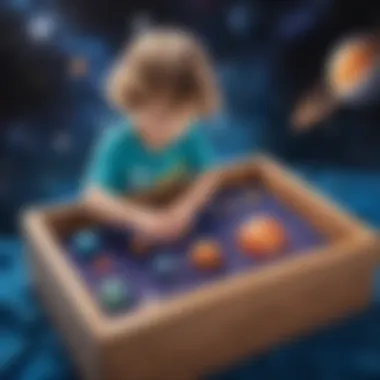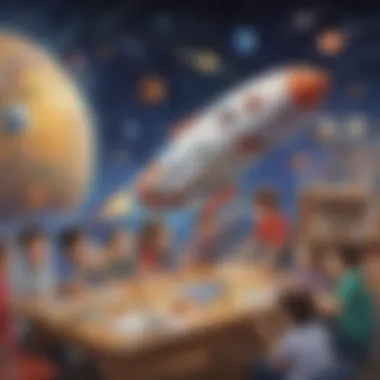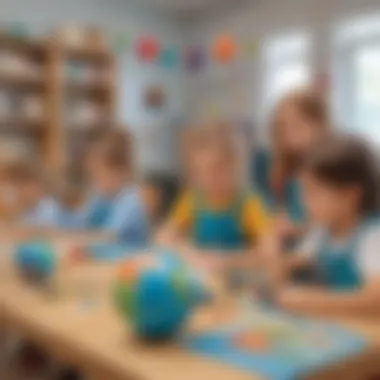Captivating Space Activities for Inquisitive Kindergarteners


Fun Activities Ideas
In the vast cosmos of space-themed activities for kindergarten children, engaging in both indoor and outdoor adventures can spark their imagination and curiosity. While indoor activities like creating papier-mâché planets or constructing a mini rocket ship provide a hands-on approach to learning about space, outdoor explorations under the night sky observing stars and planets through a telescope offer a direct connection to the wonders of the universe. Arts and crafts activities such as making galaxy slime or designing alien masks allow children to express their creativity while delving into the mysteries of space.
Educational Games
Integrating educational games into a kindergarten curriculum can make learning about space both fun and informative. Math and logic games like 'Space Race' or 'Planet Patterns' can help children grasp key concepts such as counting planets or recognizing shapes in a space-themed context. Language and vocabulary games such as 'Astro Alphabet' promote literacy skills through space-related words and definitions. Introducing STEM activities like building a Mars rover or designing a lunar habitat encourages critical thinking and problem-solving skills. History and geography puzzles centered around space exploration milestones or planetary facts offer a comprehensive understanding of the vast expanse beyond Earth. Interactive learning apps like 'Stellar Stargazing' or 'Galactic Explorer' bring the cosmos to life through immersive experiences.
Seasonal and Holiday Activities
Throughout the year, seasonal and holiday-themed space activities can add a touch of festivity to a kindergarten space exploration curriculum. Valentine's Day crafts like creating heart-shaped constellations or making space-themed valentines can infuse love into astronomical wonders. Halloween costume ideas inspired by astronauts or alien beings allow children to dress up and embody space-related characters. Thanksgiving cooking projects incorporating edible planetary models or astronaut-themed treats blend culinary arts with space exploration. Christmas decorations such as DIY galaxy ornaments or snowman space shuttles can sprinkle holiday cheer in a cosmic setting. New Year's resolutions for kids can include setting space-related goals such as learning about the planets or keeping a moon observation journal.
Parenting Tips and Resources
For parents, guardians, and educators, nurturing a child's interest in space activities requires a supportive and enriching environment. Encouraging creativity through open-ended space-themed projects allows children to explore their imagination and problem-solving skills. Setting up a playful learning environment with space-themed decorations or designated space corners sparks curiosity and engagement. Balancing screen time and playtime by integrating educational space apps or interactive activities ensures a well-rounded approach to learning about the universe. Building strong family bonds through collaborative space projects or stargazing nights fosters connection and shared experiences. Motivating kids to stay active by organizing space-themed outdoor games or cosmic treasure hunts promotes physical activity while engaging with space concepts.
Fun Facts and Trivia
Immersing children in the realm of space exploration goes beyond activities; sharing fun facts and trivia can enrich their knowledge and curiosity. Discovering fascinating details about the animal kingdom in space, such as how spiders spin webs differently in microgravity, sparks intrigue and learning. Exploring famous inventions stories related to space technologies, like Velcro inspired by NASA innovation, showcases the impact of space exploration on everyday life. Delving into historical events for kids, such as astronaut missions or moon landings, offers a glimpse into humanity's achievements beyond Earth. Uncovering mythical creatures like moon dragons or Martian rovers in children's literature bridges imagination with space themes. Narrating space adventures and discoveries, from the Apollo moon missions to the latest Mars rover landings, instills a sense of wonder and curiosity in budding space enthusiasts.
Introduction to Space Exploration
Importance of Early Learning in Space
Stimulating Curiosity
Stimulating Curiosity is a vital aspect of early learning in space exploration. By piquing children's interest and encouraging them to ask questions, this approach serves as a gateway to exploration and discovery. Kindergarteners are naturally inquisitive, and by engaging their curiosity through space-themed activities, they develop a thirst for knowledge that will guide them throughout their educational journey. Offering a way to make abstract concepts tangible and exciting, Stimulating Curiosity plays a pivotal role in shaping young minds.
Inspiring Scientific Interest


Inspiring Scientific Interest among kindergarteners is key to nurturing a future generation of scientists and space enthusiasts. By exposing children to scientific concepts in a fun and interactive manner, educators can ignite a passion for exploration that goes beyond the confines of the classroom. Through hands-on experiences and engaging activities, young learners can develop a deeper appreciation for the wonders of the universe, setting the stage for a lifelong interest in science.
Fostering Imagination
Fostering Imagination is a fundamental component of early space education. Encouraging kindergarteners to think creatively and envision limitless possibilities stimulates their cognitive development and nurtures their innate creativity. By immersing children in imaginative activities that involve space exploration, educators not only spark their imaginations but also cultivate vital skills such as problem-solving and innovation. Through fostering imagination, young learners can transcend the boundaries of reality and embark on exciting mental journeys.
Benefits of Space Activities for Kindergarteners
Developing Critical Thinking
Engaging in space activities aids in Developing Critical Thinking skills among kindergarteners. By presenting challenges that require logical reasoning and strategic planning, children learn to analyze situations and make informed decisions. Through space-themed puzzles and games, young learners can enhance their ability to think critically, laying a solid foundation for academic success and future problem-solving scenarios.
Enhancing Problem-Solving Skills
Enhancing Problem-Solving Skills through space activities equips kindergarteners with valuable tools for overcoming obstacles. By presenting children with tasks that demand innovative solutions, educators encourage them to think outside the box and approach challenges with a creative mindset. From constructing spacecraft to solving cosmic mysteries, engaging in space-themed activities fosters resilience, adaptability, and a growth mindset essential for navigating the complexities of the modern world.
Encouraging Teamwork
Space activities play a significant role in Encouraging Teamwork among kindergarteners. By fostering collaboration and communication skills, children learn the value of working together towards a common goal. Through group projects and interactive games centered around space exploration, young learners develop essential social skills that prepare them for future success in academic and professional environments. Encouraging teamwork not only promotes a sense of camaraderie but also instills in children the importance of cooperation and mutual respect.
Hands-On Space Crafts
Creating a Solar System Mobile
Materials Needed
When considering the materials needed for creating a solar system mobile, it's crucial to prioritize safety, durability, and educational value. Opt for lightweight materials such as foam balls, string, paint, and labels to represent the planets accurately. These materials not only ensure ease of assembly but also allow children to learn about the solar system in a hands-on manner. The unique feature of these materials lies in their versatility and suitability for young learners, making them a popular choice for this article.
Step-by-Step Instructions
Providing clear and concise step-by-step instructions is essential for guiding children through the craft process smoothly. Start by painting the foam balls to resemble the planets and attaching them to the string at varying lengths to depict the solar system's structure accurately. Incorporating facts about each planet during assembly can further enhance the learning experience. The detailed instructions offer a structured approach while encouraging children to explore their creativity and attention to detail.


Learning Objectives
The objective of creating a solar system mobile extends beyond the craft itself. Through this activity, children develop an understanding of planetary bodies, their relative sizes, and positions in the solar system. The hands-on experience fosters inquiry and curiosity about the universe, sparking an early interest in astronomy and space exploration. By combining art with science, the learning objectives emphasize interdisciplinary learning, critical thinking, and a holistic approach to education.
Interactive Space Games
Interactive space games play a pivotal role in this article as they provide a stimulating and immersive way for kindergarten children to learn about space. By engaging in interactive activities, kids can develop a keen interest in space exploration from a young age, laying a solid foundation for future learning. These games foster curiosity, critical thinking, and teamwork among children, making the learning experience both educational and enjoyable.
Astronaut Training Obstacle Course
Setting Up the Course
Exploring the specific aspect of setting up the astronaut training obstacle course is essential for creating an exciting and challenging environment for young explorers. By carefully planning and arranging different obstacles such as tunnels, balance beams, and climbing walls, the course can provide a holistic experience that simulates the challenges astronauts face in space. The unique feature of this setup lies in its ability to enhance physical coordination, problem-solving skills, and spatial awareness in children, making it a popular choice for this article. While the setup requires space and equipment, its immersive nature and hands-on approach offer numerous advantages in strengthening children's motor skills and cognitive development.
Physical Challenges
Delving into the physical challenges segment of the obstacle course, children engage in activities that test their agility, strength, and resilience. These challenges not only encourage physical activity but also promote perseverance and determination. The key characteristic of these challenges is to provide a safe yet exciting environment where children can push their boundaries and discover the thrill of overcoming obstacles. By incorporating activities like crawling through tunnels, balancing on beams, and climbing walls, the physical challenges segment aims to enhance children's gross motor skills, coordination, and confidence. While each challenge presents its own set of difficulties, the overall experience fosters a sense of accomplishment and resilience in young participants.
Team Building Elements
Team building elements are a crucial component of the astronaut training obstacle course, fostering cooperation, communication, and collaboration among children. By working together to navigate the course, kids learn the value of teamwork and mutual support. The key characteristic of these elements is to promote social interaction and empathy, essential skills for interpersonal relationships. Through activities that require joint problem-solving and coordination, children develop a strong sense of belonging and camaraderie. While challenges may vary in complexity, the shared goal of completing the course as a team reinforces the importance of unity and cooperation. By emphasizing the significance of working together, the team building elements enhance children's social skills, empathy, and respect for others.
Educational Space Exploration
In this article, we delve into the fascinating realm of Educational Space Exploration, aimed at kindergarteners. Understanding the importance of instilling scientific curiosity from a young age is crucial. By introducing children to concepts like stargazing, constellation identification, and rocket science experiments, we lay the foundation for a future generation of aspiring astronauts and astrophysicists. Educational Space Exploration not only sparks interest but also nurtures critical thinking, problem-solving skills, and teamwork.
Stargazing Night
Observation Tools
Observation Tools play a vital role in allowing young learners to explore the night sky. Telescopes, binoculars, and star charts enhance their ability to observe celestial bodies in detail. The high-quality lenses in telescopes offer a clear view of planets, stars, and galaxies, fostering a deeper understanding of the universe. While observing constellations and planets, children develop an appreciation for the vastness of space.


Constellation Identification
Constellation Identification introduces children to the patterns formed by stars in the night sky. By identifying constellations like the Big Dipper or Orion, kindergarteners learn about the cultural significance and stories behind these celestial formations. This activity not only sharpens observational skills but also sparks curiosity about mythology and the history of astronomy.
Night Sky Wonder
The Night Sky Wonder captivates young minds with its beauty and mystique. Gazing up at the stars instills a sense of awe and wonder, encouraging children to contemplate the vastness of the universe. Amidst the dark canvas of the night sky, young explorers can let their imaginations roam freely, dreaming of future space adventures and discoveries.
Rocket Science Experiments
Launching Rockets Safely
Launching Rockets Safely involves meticulous preparation and attention to detail. By teaching kindergarteners the importance of following safety protocols, we instill a sense of responsibility and caution. Emphasizing safe launch practices ensures that children can explore the thrills of rocket science in a controlled and secure environment.
Measuring Distances
Measuring Distances during rocket experiments introduces children to basic concepts of physics and mathematics. By estimating the height and distance covered by their rocket creations, kids engage in hands-on learning that is both fun and educational. This activity encourages precision and accuracy, setting the stage for future scientific pursuits.
Critical Analysis
Critical Analysis of rocket performance allows young learners to reflect on their experiments and make data-driven conclusions. By analyzing factors like launch angle, propulsion methods, and flight trajectory, kindergarteners develop analytical skills crucial for problem-solving. Encouraging critical thinking fosters a mindset of exploration and discovery among budding space enthusiasts.
Conclusion: Inspiring Young Explorers
Encouraging Lifelong Learning
Continued Curiosity
Diving into the realm of Continued Curiosity, we explore its pivotal role in fueling a child's quest for knowledge and exploration. This aspect emphasizes the ongoing desire to seek understanding, ask questions, and delve deeper into the mysteries of the cosmos. Continued Curiosity stands out as a fundamental trait that drives children to explore beyond the surface level, nurturing a sense of wonder and inquisitiveness that is essential for lifelong learning. Its ability to sustain engagement and stimulate intellectual growth makes it a cornerstone of educational initiatives like this article, where the goal is to cultivate a passion for learning through space activities.
Future Scientific Endeavors
Turning our focus to Future Scientific Endeavors, we uncover its instrumental contribution to shaping young minds towards embracing the world of science and technology. This facet accentuates the importance of nurturing young talents to become future pioneers in scientific innovation and exploration. By igniting a sense of wonder and excitement about the possibilities of scientific discovery, children are inspired to dream big and pursue careers in STEM fields. Future Scientific Endeavors play a crucial role in bridging the gap between curiosity and discovery, laying the groundwork for a generation of aspiring scientists and explorers.
Innovation in Education
Exploring the realm of Innovation in Education, we recognize its transformative impact on reshaping traditional teaching methods to align with the needs of 21st-century learners. This aspect highlights the power of incorporating new technologies, interactive tools, and experiential learning techniques to create dynamic and engaging educational experiences. Innovation in Education fosters creativity, critical thinking, and problem-solving skills, essential attributes for preparing children to thrive in a rapidly evolving world. By leveraging innovative teaching approaches in activities like space exploration, educators can inspire a new generation of innovative thinkers and lifelong learners. It is through embracing innovation that the educational landscape continues to evolve, offering limitless possibilities for enriching young minds through engaging and interactive learning adventures.



